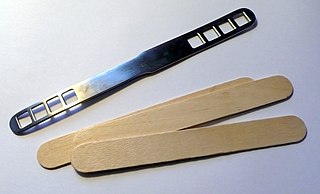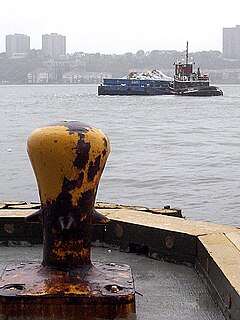Related Research Articles
Medical physics is a profession which deals with the application of the concepts and methods of physics to the prevention, diagnosis and treatment of human diseases with a specific goal of improving human health and well-being. Since 2008, medical physics has been included as a health profession according to International Standard Classification of Occupation of the International Labour Organization.

A scintillation counter is an instrument for detecting and measuring ionizing radiation by using the excitation effect of incident radiation on a scintillating material, and detecting the resultant light pulses.

Health physics, also referred to as the science of radiation protection, is the profession devoted to protecting people and their environment from potential radiation hazards, while making it possible to enjoy the beneficial uses of radiation. Health physicists normally require a four-year bachelor’s degree and qualifying experience that demonstrates a professional knowledge of the theory and application of radiation protection principles and closely related sciences. Health physicists principally work at facilities where radionuclides or other sources of ionizing radiation are used or produced; these include research, industry, education, medical facilities, nuclear power, military, environmental protection, enforcement of government regulations, and decontamination and decommissioning—the combination of education and experience for health physicists depends on the specific field in which the health physicist is engaged.

Radioactive contamination, also called radiological contamination, is the deposition of, or presence of radioactive substances on surfaces or within solids, liquids or gases, where their presence is unintended or undesirable.

A medical device is any device intended to be used for medical purposes.Significant potential for hazards are inherent when using a device for medical purposes and thus medical devices must be proved safe and effective with reasonable assurance before regulating governments allow marketing of the device in their country. As a general rule, as the associated risk of the device increases the amount of testing required to establish safety and efficacy also increases. Further, as associated risk increases the potential benefit to the patient must also increase.
The rad is a unit of absorbed radiation dose, defined as 1 rad = 0.01 Gy = 0.01 J/kg. It was originally defined in CGS units in 1953 as the dose causing 100 ergs of energy to be absorbed by one gram of matter. The material absorbing the radiation can be human tissue or silicon microchips or any other medium.

A bollard is a sturdy, short, vertical post. The term originally referred to a post on a ship or quay used principally for mooring boats. It now also refers to posts installed to control road traffic and posts designed to prevent automotive vehicles from colliding or crashing into pedestrians and structures, whether intentional from ram-raids and vehicle-ramming attacks, or unintentional losses of control.

The Bhabha Atomic Research Centre (BARC) formerly known as Atomic Energy Establishment, Trombay is India's premier nuclear research facility, headquartered in Trombay, Mumbai, Maharashtra. Founded by Homi Jehangir Bhabha Atomic Energy Establishment, Trombay (AEET) in January 1954 as a multidisciplinary research program essential for the india's nuclear program. It operates under the Department of Atomic Energy(DAE) which is directly overseen by the Prime Minister of India. In 1966 after the death of Homi Jehangir Bhabha AEET renamed as Bhabha Atomic Research Centre (BARC) BARC is a multi-disciplinary research centre with extensive infrastructure for advanced research and development covering the entire spectrum of nuclear science, chemical engineering, material sciences & metallurgy, electronic instrumentation, biology and medicine, supercomputing, high-energy physics and Plasma physics and associated research for Indian nuclear programme and related areas.

Special nuclear material (SNM) is a term used by the Nuclear Regulatory Commission of the United States to classify fissile materials. The NRC divides special nuclear material into three main categories, according to the risk and potential for its direct use in a clandestine nuclear weapon or for its use in the production of nuclear material for use in a nuclear weapon.

Industrial radiography is a modality of non-destructive testing that uses ionizing radiation to inspect materials and components with the objective of locating and quantifying defects and degradation in material properties that would lead to the failure of engineering structures. It plays an important role in the science and technology needed to ensure product quality and reliability.

A universal testing machine (UTM), also known as a universal tester, materials testing machine or materials test frame, is used to test the tensile strength and compressive strength of materials. An earlier name for a tensile testing machine is a tensometer. The "universal" part of the name reflects that it can perform many standard tensile and compression tests on materials, components, and structures.
Defence Nuclear Material Transport Operations refer to the movements of military Defence Nuclear Materials (DNM) within, to and from the United Kingdom. Defence Nuclear Material Transport Operations are also known as DNM Transportation; Defence Nuclear Material in transit; Nuclear movements; and DNM movements.

Cargo scanning or non-intrusive inspection (NII) refers to non-destructive methods of inspecting and identifying goods in transportation systems. It is often used for scanning of intermodal freight shipping containers. In the US it is spearheaded by the Department of Homeland Security and its Container Security Initiative (CSI) trying to achieve one hundred percent cargo scanning by 2012 as required by the US Congress and recommended by the 9/11 Commission. In the US the main purpose of scanning is to detect special nuclear materials (SNMs), with the added bonus of detecting other types of suspicious cargo. In other countries the emphasis is on manifest verification, tariff collection and the identification of contraband. In February 2009, approximately 80% of US incoming containers were scanned. To bring that number to 100% researchers are evaluating numerous technologies, described in the following sections.

Radiation monitoring involves the measurement of radiation dose or radionuclide contamination for reasons related to the assessment or control of exposure to radiation or radioactive substances, and the interpretation of the results.

The roentgen or röntgen is a legacy unit of measurement for the exposure of X-rays and gamma rays, and is defined as the electric charge freed by such radiation in a specified volume of air divided by the mass of that air . In 1928, it was adopted as the first international measurement quantity for ionising radiation to be defined for radiation protection, as it was then the most easily replicated method of measuring air ionization by using ion chambers. It is named after the German physicist Wilhelm Röntgen, who discovered X-rays.

Package testing or packaging testing involves the measurement of a characteristic or property involved with packaging. This includes packaging materials, packaging components, primary packages, shipping containers, and unit loads, as well as the associated processes.

Radiation Portal Monitors (RPMs) are passive radiation detection devices used for the screening of individuals, vehicles, cargo or other vectors for detection of illicit sources such as at borders or secure facilities. Fear of terrorist attacks with radiological weapons spurred RPM deployment for cargo scanning since 9/11, particularly in the United States.
Material unaccounted for (MUF), in the context of nuclear material, refers to any discrepancy between a nuclear-weapons state's physical inventory of nuclear material, and the book inventory. The difference can be either a positive discrepancy or a negative discrepancy. Nuclear accounting discrepancies are commonplace and inevitable due to the problem of accurately measuring nuclear materials. This problem of inaccurate measurement provides a potential loophole for diversion of nuclear materials for weapons production. In a large plant, even a tiny percentage of the annual through-put of nuclear material will suffice to build one or more nuclear weapons.
References
- ↑ ASTM C26.12, Guide for Application of Radiation Monitors to the Control and Physical Security of Special Nuclear Material, doi:10.1520/c1112-99r05 (subscription required)